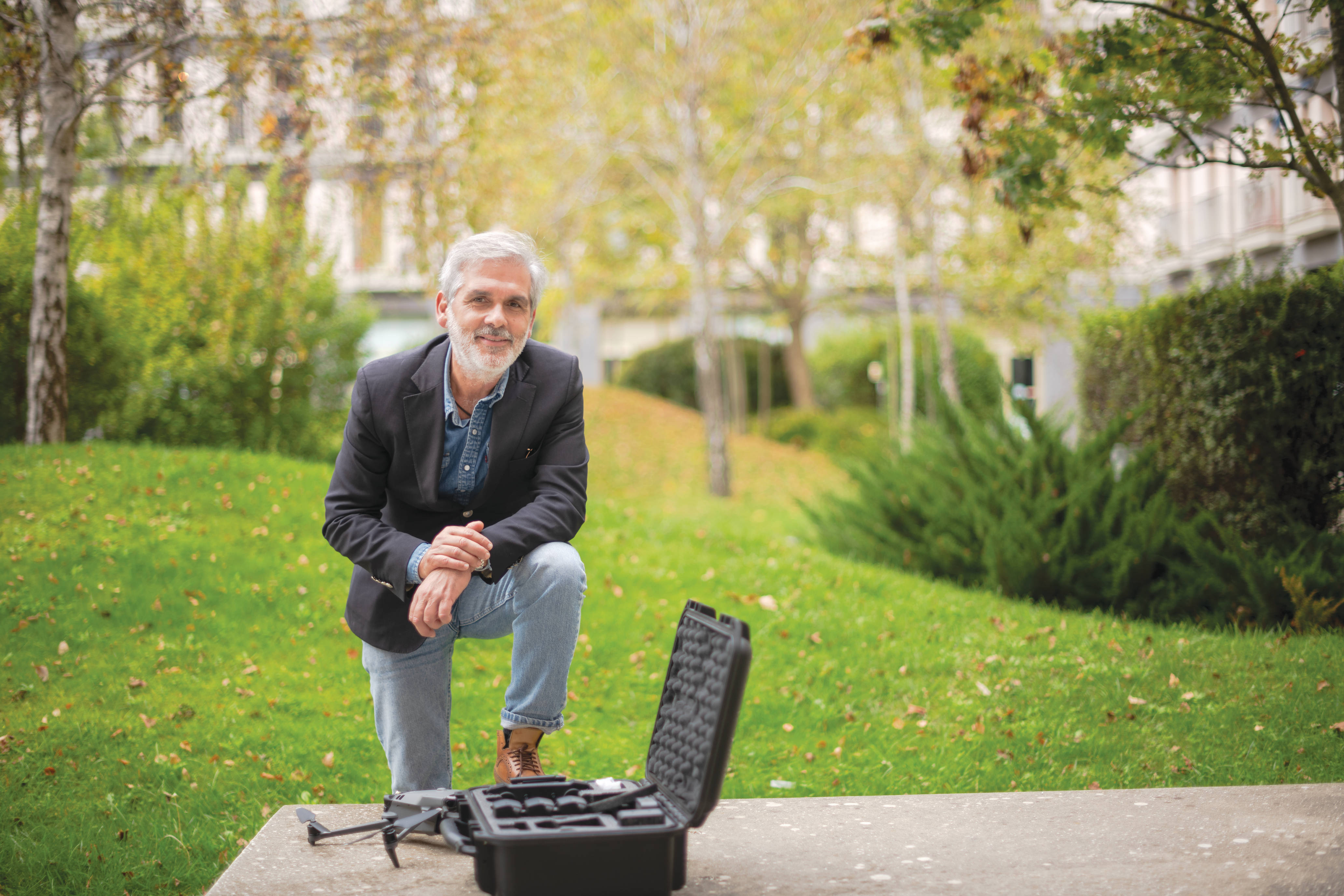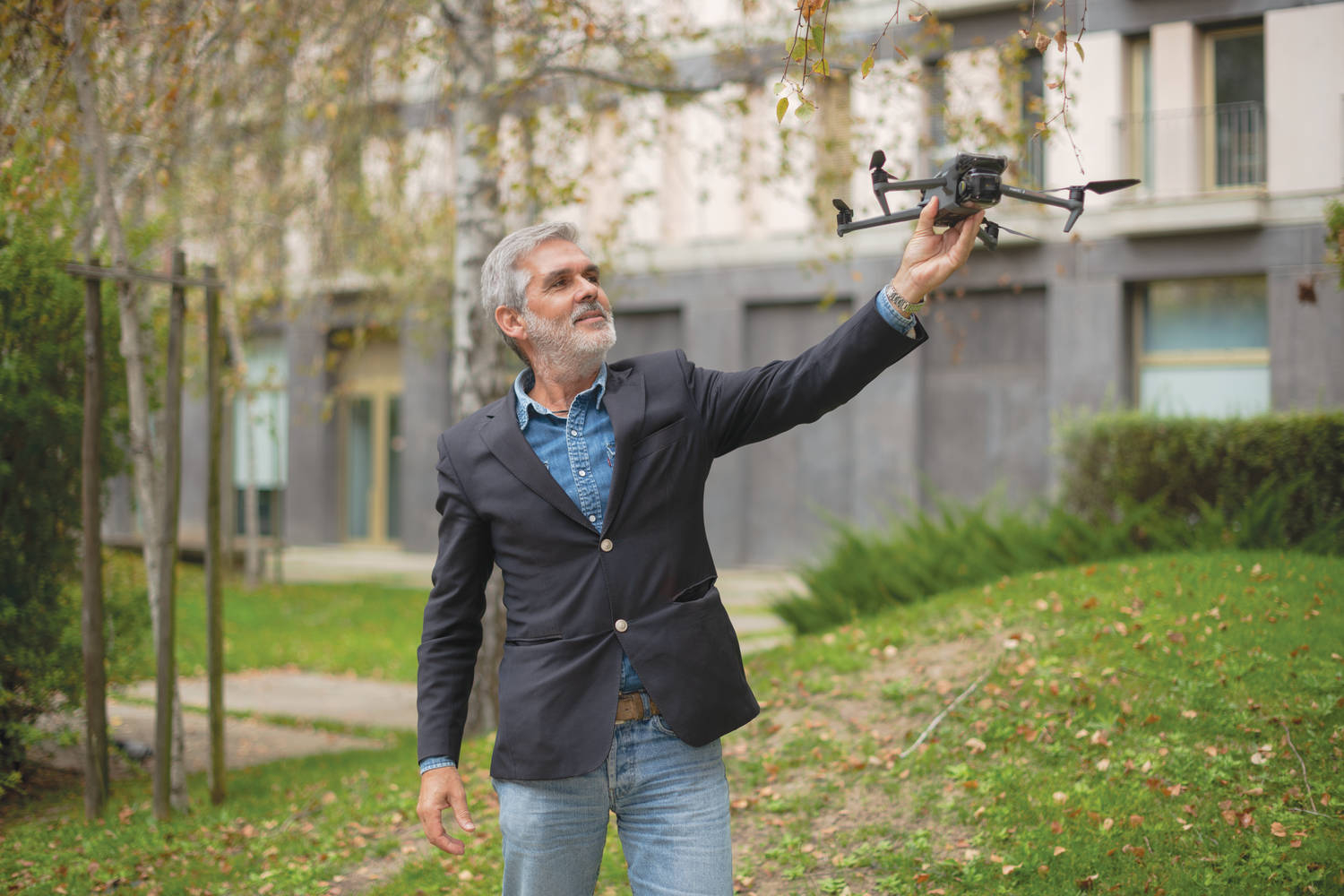News
Sustainable and smart viticulture with drones

Professor Iscte-Sintra
Researcher Institute of Telecommunications – Iscte campus
Two Iscte research centres, three wine-producing companies, and six international partners are collaborating to implement a holistic and innovative system that will transform agriculture into a digital and environmentally friendly industry.
This project has two major components, one linked to the economy and the other to technology. What is your main goal?
The project involves researchers from two research centres, BRU-Iscte and the IT-Iscte hub, two essential pillars. The central objective of SmartVitiNet – Smart and Sustainable Drone-Assisted Viticulture Excellence Network is to detect stresses, diseases, and problems and solve them. It is intended to achieve more effective and efficient forms of production through the digital transition, a challenge that agriculture does not escape.
Technology and work organisation, on the one hand, to know how we can start using drones with a set of sensors and processors that exist today. And we are already doing it with other partners, which involve academia and industry – we work with startups linked to drones. On the other hand, there is the need to know the new requirements of what the job will be, an area that is in charge of the team of Professor Sofia Kalakou (BRU-Iscte), who evaluates what the worker who will have to deal with these new technologies will be like: what type of training he will need and how a company will provide service to a farmer with the support of drones.
How is the articulation between the two pillars established?
Our journey consists of creating a competence centre in these areas, with videos and other content explaining what type of equipment is available, its interconnection to platforms and how it can be used. The IT-Iscte team is developing and testing, on an experimental basis, in partners with vineyards spread across the project's European partners.
The team will fly in the field, using RGB, thermal, and multispectral cameras to identify and collect all possible information.
In Portugal, we have three end-user partners. Our team goes to the field to make the flights and tries to identify and collect all possible information through RGB cameras, thermal cameras and multispectral cameras (they allow us to monitor small changes in visible, infrared and other wavelengths reflected by the plant). Then, we will combine all this information in a big data context and work on it. We can set a goal beyond the digital transition, encompassing environmental issues (how can I minimise/reduce water resources, phytopharmaceuticals, fertilisers, etc.).
This is being tested in entirely organic vineyards, but we need information for more sustainable production. We are in an experimental phase, in which we are still testing the algorithms.
In Portugal, for example, this is being tested in two end users, in the north, in the Douro region (in the Ribadouro and Casa do Joa vineyards) and, in a third, in the Sintra/Colares area (in the Ramilo Wines).
The team will fly in the field, using RGB, thermal, and multispectral cameras to identify and collect all possible information
What does this experimental phase consist of?
We develop the tests in a pilot project, and then we move on to implementation. It is essential to be aware of the difference between small holdings and large estates. This is being tested in a smallholding environment because another type of fixed-wing drone, plane, etc., is used in a large estate.
We are using a vertical-take-off drone. We have access to the platform and have created a series of options following the mission plan. We also accompany modern farmers interested in the digital transition, teaching them how to operate this mechanism: You go to the platform, collect the data obtained by the reconnaissance flyover, and based on the algorithms on the platform, pass the recommendations on to another drone, which will implement them.
What is the role of the partners of Greece, Cyprus and France?
Greece and Cyprus have end users in the project who also do tests, and the drones are either here or in these countries. In viticulture, this type of work must be mapped in seasons of complete campaigns so that we can observe the various phases, from pruning to the time of grape harvesting.
Does the project have any limitations in terms of the equipment available?
Yes, there are limitations. For example, Portugal would need to have equipment in the north and south throughout the campaign. However, these drones are expensive, and the funding from the European Commission only allows various partners to share them.
Are there or have projects been developed like this one?
Iscte founded the Collaborative Laboratory in the Area of Digital Agriculture – Smart Farm CoLab (*). With this laboratory, we started the digital transition in the agricultural sector through the marriage of drones and sensors, some buried in the ground, and in management platforms to predict the harvest and know agricultural production's economic, social and environmental impact.
We have also started courses for new farmers, who already need to adapt to a different mindset: organic production, at an early stage, requires a balance of resources.
In summary, we have explored these themes in other projects supported by Europe or at a national level. We had a mobilising project within the scope of the Smart Farm Colab that involved a consortium of about twenty entities, including industry, municipalities and organisations of the national scientific system. We did things with the support of drones and electric vehicles, for example, in the new spraying forms. Instead of being with a tractor, we used an electric vehicle with a robotic arm to spray, explore picking fruit in an orchard or tomatoes in the garden, and immediately evaluate the product regarding ripeness. I believe that we have contributed to developing "toys" through digitisation and automation of work.
(*) The SFCOLAB Association – Collaborative Laboratory for Digital Innovation in Agriculture is a private non-profit in Torres Vedras. It is allocated to INIAV – The National Institute of Agrarian and Veterinary Research, I.P., is in Dois Portos. Founded in 2019, the collaborative laboratory, which involves about 20 partners, aims to boost innovation and the digital transition in agriculture. Iscte was at the start of this project as a partner entity. Its funding comes from the Portuguese Innovation Agency, under Portugal 2020.
How did Iscte integrate this project?
Shared projects often occur through researchers' networks of contacts. The University of Agronomy of Athens led this project, which came to Iscte thanks to Professor Sofia Kalakou, who has this bridge with Greece.
Iscte has competencies in various areas, from information systems to social sciences, management, etc. With all our know-how, we need to "get the orchestra working". In the case of the project, we brought together two areas: communications and processing technology, management areas, and sustainability.

Iscte's strategic orientation is interdisciplinary research. Do you see yourself in this view?
Totally. This is the origin of our research. I am not a fundamentalist, but I have thought collaboration has to be increasingly multidisciplinary for some years now. And, in the current moment of scientific advancement, what is essential is to bring people together, have innovative ideas and make innovative products or services supported by science. Iscte has all the characteristics to make this marriage, and the people who work here are, from a human point of view, very good and capable of building these bridges.
Research for technology transfer
"Today research cannot be focused only on papers. It requires technology, information and knowledge transfer to influence decision and public policies. I defended this very thing in my lesson for the Aggregation, entitled 'From science to market'.
I believe that Iscte has differentiating and unique characteristics since its foundation and brings together a set of schools that have this know-how.
Iscte-Sintra, for example, uses a methodology based on developing new products and processes based on innovation.
What fascinates me most is creating things that work, not just staying on paper. And leaving a mark.
With other partners in different time zones and budget constraints, how has collaborative work gone?
There is a road map and a timeline drawing; we know what tasks each partner must develop, and we have fulfilled them. And, with the meetings predominantly online, we give and receive indications.
What can be said regarding the results of this project?
There will be a final workshop, as in all projects.
Regarding results for society, we will have a Competence Centre in which the winegrowers who follow this process can be trained, clarify doubts, and know what kind of future skills their human resources will need. That centre at the European level is the hat of the European Commission. We are already making didactic videos for this centre, ranging from taking the drone out of the package, explaining how to proceed, and going to the field. A fully open platform will be available.